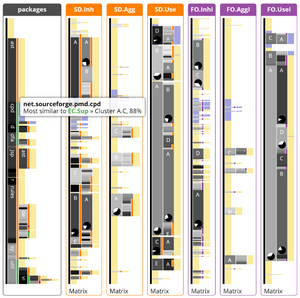Die Arbeitsgruppe zieht um!
Wir wechseln im Wintersemester 2021/22 an die Universität Bamberg. Ab 15. Oktober 2021 übernimmt Fabian Beck den dortigen Lehrstuhl für Informationsvisualisierung.
Neue Webseite der Arbeitsgruppe: https://www.uni-bamberg.de/vis
Publikationen
Publikationen der Arbeitsgruppe, die seit 2016 erschienen sind. Frühere Publikationen von Fabian Beck sind auf Google Scholar oder DBLP zu finden.

Art der Publikation: Beitrag in Sammelwerk
Identifying Modularization Patterns by Visual Comparison of Multiple Hierarchies
- Autor(en):
- Beck, Fabian; Melcher, Jan; Weiskopf, Daniel
- Titel des Sammelbands:
- Proceedings of the 2016 IEEE 24th International Conference on Program Comprehension
- Seiten:
- 1-10
- Verlag:
- IEEE
- Veröffentlichung:
- 2016
- Digital Object Identifier (DOI):
- doi:10.1109/ICPC.2016.7503712
- Volltext:
- Identifying Modularization Patterns by Visual Comparison of Multiple Hierarchies (1.51 MB)
- Zitation:
- Download BibTeX
Kurzfassung
Software is modularized to make its high complexity manageable. However, a multitude of modularization criteria exists and is applied. Hence, to extend, reuse, or restructure a system, it is important for developers to understand which criteria have been used. To this end, we provide an interactive visualization approach that compares the current modularization of a system to several software clustering results. The visualization is based on juxtaposed icicle plot representations of the hierarchical modularizations, encoding similarity by color. A detailed comparison is facilitated by an advanced selection concept. Coupling graphs, which form the basis for software clustering, can be explored on demand in matrix representations. We discuss typical modularization patterns that indicate criteria used for structuring the software or suggest opportunities for partial remodularization of the system. We apply the approach to analyze 16 open source Java projects. The results show that identifying those modularization patterns provides valuable insights and can be done efficiently.
